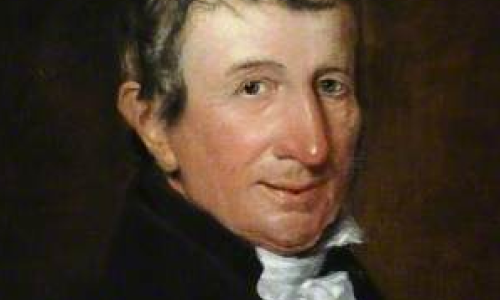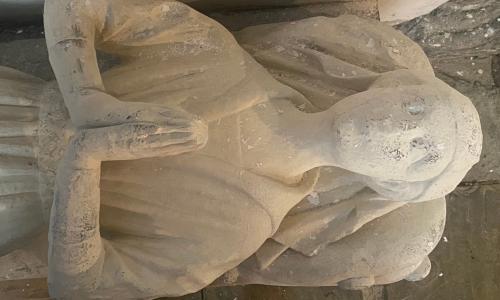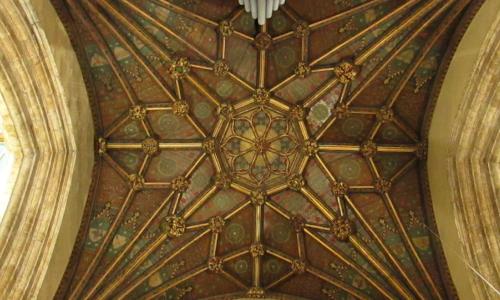Jacques Parmentier (also known as James in English) was born in France in 1658. He came to England first in 1676, during the reign of Charles II. His portrait of the king is in the National Portrait Gallery. The king's nephew William of Orange noticed his work and so he went to the Netherlands to paint ceilings and chimney-pieces for Dutch royal palaces. He returned to London in the early 1700s, but as work dried up he travelled to Yorkshire, where he worked as a portrait painter. In 1711 Parmentier was engaged by Holy Trinity Church, Hull, to paint a picture entitled "The Lord's Supper" at the east end of the church. This was completed and paid for on 14th May 1712. He was paid a princely sum of £50. In today's money this represents approximately £5000. In 1711 it was equivalent to 9 horses or 83 stones of wool or 555 days of skilled labour (https://www.nationalarchives.gov.uk/currency-converter).
Parmentier also painted a ceiling at St Peter's, Leeds, depicting Moses receiving the law. He returned to London in the 1720s, and died there in 1730. he is buried at St Paul's, Covent Garden.
In 1796 John Tickell described the work:
“over the Altar Piece (Communion Table) all is portrayed to the life; the Last Supper of our Blessed Saviour and his Apostles, which occupies a considerable space of the East Window. This is allowed by all who see it, to be a masterly piece of painting and does honour to the abilities of the artist, Monsieur Parmentier, who, notwithstanding it seems, met with a reward very inadequate to the excellency of his work.”
At this time the east end of the church had a shambles (or market) attached to the end, so the lower part of the east window was completely boxed in. The painting was designed to be a backdrop to the altar which resided against the east wall. This was at a time before the raised Chancel and stone screens were erected and the east end would have been relatively flat and clear. The picture below shows the east end before the screens were installed from a point right next to the Parmentier picture and altar.
Scroll forward one hundred years or so and the east window is in need of repair. The whole church is undergoing restoration by Henry Lockwood and the east window needs significant repair. The market hall outside is no longer obstructing the window and so John Healy Bromby, along with churchwardens, Mercer and Keddey, place a notice in the Hull Packet on Tuesday 18th August 1829 stating their intention to remove it and explaining that it cannot be repaired by the people of Holy Trinity owing to the cost. A new window, however is intended to be put in place above where the painting once stood. They point out that the painting is not on canvas or wood but painted directly to plaster which will be tricky to remove.
Here begins the picture's strange journey on a horse drawn wagon to Hessle.
Hessle was the "mother church" of Holy Trinity and, until 1661 had jurisdiction about what happened at Holy Trinity, with the vicars and curates travelling from Hessle to undertake the clergy duties.
Joseph Robinson Pease, who was connected to All Saints' Church, Hessle, thought that the painting would be a splendid addition to its interior and paid for its transportation, conservation and installation as a gift to the parishioners. " I make a present of it to the Mother Church and hope it will be taken care of in future". (Journal of Joseph Robinson Pease, 1822-1844).
In his diary of 25th September 1831 he catalogues the events. At a cost of £20 , he employs a Mr Hutchinson, a builder in Hull, to remove the painting and bring it to Hessle. It was an enormous task requiring pulleys, heavy labour and a horse drawn wagon. The painting is so dirty and damaged that the people in it cannot be seen very clearly, he says " scarcely a feature could be seen, nay several figures were altogether lost". It weighs 2 tonnes and is too large for the space allocated at Hessle, so it is trimmed to 16ft by 10ft so that it will fit. This is why only 10 apostles feature in the window instead of the usual 12.
Pease recognises that key features of the window will be lost. These include the window light above the head of Jesus, and apostle kneeling to the right hand side and "Judas who was walking away on the left hand side". It was restored by George Buttery at a cost of £15. He removed layers for varnish and dirt from the painting, and once installed in Hessle, Pease writes, "the beauties came out in the cleaning and it was finished then it was appreciated."
Sadly, the portions of the window that were cut off were not kept and we have no idea what they looked like. In "restoration" it is possible that the features of the group and but appearance of the picture will have changed considerably from its original state.
But why did it return to Holy Trinity?
Only 37 years later in 1868, All Saints Church in Hessle undertook an enormous restoration programme under the direction of vicar Joseph Walker Pease. This involved strengthening and rebuilding walls, widening the aisles, and adding a porch.
At this time, Holy Trinity also began a long restoration programme under architect George Gilbert Scott. So, the Parmentier paining was brought back to Holy Trinity. Now shorter and narrower, a place was found for it in the North Choir Aisle, covering an archway which led to a medieval chapel (the arch can still be seen from the outside). Unfortunately, the missing apostles were never replaced and the central window is still missing.




